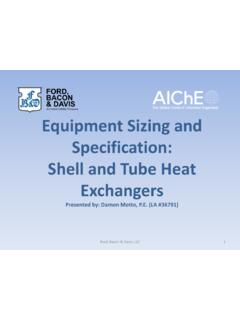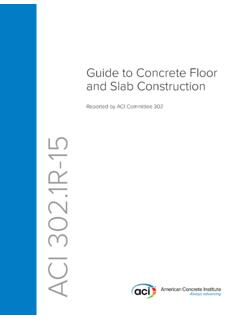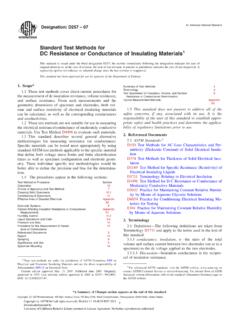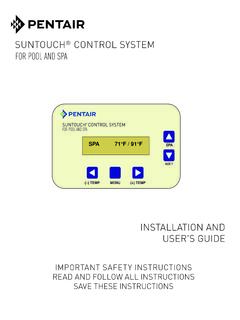Transcription of Thermal Processing o Food - Tiselab
1 Thermal Processing of FoodPage 1 Safefood 360, Inc. 2014 Part of Our Professional Whitepapers SeriesThe use of high tempera-tures to preserve and ensure the safety of f ood is based on the effect of microbial destruction. Thermal pro-cessing is one of the most widely used unit operations employed in the food indus-try and is frequently deter-mined as a Critical Control Point (CCP). This whitepaper covers the main science be-hind the unit operation and should be used to underpin the development and design of Thermal Processing Blanching and enzyme Methods of Testing of the effectiveness of Purpose of Method for Canned Conditions affecting the growth Micro-organisms in retorted Microbial spoilage of canned Sterilisation process and Containers for thermally treated Cleaning of containers prior to Seaming of Death rate curve (D value) Thermal death time (TDT)
2 Some factors affecting heat Design of heat sterilization The F0 value The lethality factor l Safefood 360 is the provider of food safety management software for industry leading Processing of FoodThermal Processing of FoodPage 2 Safefood 360, Inc. 2014 Part of Our Professional Whitepapers are two main temperature categories employed in Thermal Processing : Pasteurization and Sterilisation. The basic purpose for the Thermal Processing of foods is to reduce or destroy microbial activity, reduce or destroy enzyme activity and to produce physical or chemical changes to make the food meet a certain quality standard. gelatenization of starch & denaturation of proteins to produce edible food.
3 There are a number of types of heat Processing employed by the food primary purpose of blanching is to destroy enzyme activity in fruit and vegetables. It is not intended as a sole method of preservation, but as a pre-treatment prior to freezing, drying and canning. Other functions of blanching include: Reducing surface microbialcontamination Softening vegetable tissues tofacilitate filling into containers Removing air from intercellularspaces prior to Blanching and enzyme inactivationFreezing and dehydration are insuffcient to inactivate enzymes and therefore blanching can be employed. Canning conditions may allow suffcient time for enzyme activity.
4 Enzymes are proteins which are denatured at high temperatures and lose their activity. Enzymes which cause loss of quality include Lipoxygenase, Polyphenoloxidase, Polygaacturonase and Chlorophyllase. heat resistant enzymes include Catalase and Methods of BlanchingBlanching is carried out at up to 100 C using hot water or steam at or near atmospheric use of fluidised bed blanchers, utilising a mixture of air and steam, has been reported. Advantages include faster, more uniform heating, good mixing of the product, reduction in effluent, shorter Processing time and hence reduced loss of soluble and heat sensitive components. There is also some use of microwaves for blanching.
5 Advantages include rapid heating and less loss of water soluble components. Disadvantages include high capital costs and potential diffculties in uniformity of heating. Mild processesBlanching PasteurisationMore severe processesCanning Baking Roasting Frying Thermal Processing of FoodPage 3 Safefood 360, Inc. 2014 Part of Our Professional Whitepapers SeriesSteam BlanchersThis is the preferred method for foods with large cut surface areas as lower leaching losses. Normally food material carried on a mesh belt or rotatory cylinder through a steam atmosphere, residence time controlled by speed of the conveyor or rotation. Often poor uniformity of heating in the multiple layers of food, so attaining the required time-temperature at the centre results in overheating of outside Quick Blanching (IQB) involves a first stage in which a single layer of the food is heated to suffcient temperature to inactivate enzymes and a second stage in which a deep bed of the product is held for suffcient time to allow the temperature at the centre of each piece to increase to that needed for reduced heating time ( for 10 mm diced carrot, 25 s heating and 50 s holding compared with 3 minutes conventional blanching)
6 Results in higher energy effcienciess For small products es gs peas, sliced or diced carrots), mass of produce blanched per kg steam increases from for conventional steam blanchers to 6-7kg for IQB. Hot Water BlanchersIncludes various designs which hold the food in hot water (70 to 100 C) for a specified time, then moves it to a dewatering/cooling section. In blanchers of this type the food enters a slowly rotating drum, partially submerged in the hot water. It is carried along by internal flights, residence time being controlled by the speed of blanchers consist of insulated tubes through which hot water is circulated. Food is metered into the stream, residence time being controlled by the length of the pipe and velocity of the water.
7 The blancher-cooker has three sections, a preheating stage, a blanching stage, and a cooling stage. As the food remains on a single belt throughout the process, it is less likely to be physically damaged. With the heat recovery incorporated in the system, 16 to 20 kg of product can be blanched for every kg of steam, compared with to per kg stream in the conventional hot water blanchers. Testing of the Effectiveness of BlanchingOver blanching causes quality loss due to overheating while under blanching causes quality loss due to increased enzyme activity because enzymes activated and substrates released by heat . The Peroxidase test in vegetables is used to detect enzyme inactivation.
8 This enzyme is not in itself implicated in degradation, but is relatively heat resistant and easily detected. It consists of adding guaiacol solution and hydrogen peroxide solution and observing the development of a brown colour indicating peroxidase activity. Thermal Processing of FoodPage 4 Safefood 360, Inc. 2014 Part of Our Professional Whitepapers SeriesComplete inactivation is not always essential green beans, peas and carrots with some residual peroxidase activity have shown adequate storage quality at -20 C through with other vegetable ( Brussels sprouts) zero peroxidase activity is essential. Purpose of Pasteurization Pasteurization is a relatively mild heat treatment in which food is heated to <100 C.
9 It is widely used throughout the food industry and is frequently employed as a CCP in various HACCP plans. As a unit operation in food Processing it can be used to destroy enzymes and relatively heat sensitive micro-organisms ( non spore forming bacteria, yeast and moulds). In this regard is it used to extend shelf life by several days milk or months bottled fruit. The severity of treatment and resulting extension of shelf life is determined mostly by pH of the food. In low acid foods (pH< ), the main purpose is destruction of pathogenic bacteria, while below pH the destruction of spoilage microorganisms or enzyme deactivation is usually more important.
10 The extent of heat treatment required is determined by the D value (Decimal reduction time or time to reduce numbers by a factor of 10 or 90% of the initial load) of most heat resistant enzyme or micro-organism which may be present. In terms of checking the effectiveness of the process, alkaline phosphatase is a naturally occurring enzyme in raw milk with a similar D value to heat -resistant pathogens and so is routinely used as an indicator of adequate pasteurisation. If phosphatase activity is found, it is assumed that pasteurisation is is normally used for the destruction of all disease causing organisms ( pasteurization of milk) or the destruction or reduction in the number of spoilage organisms in certain foods vinegar.









